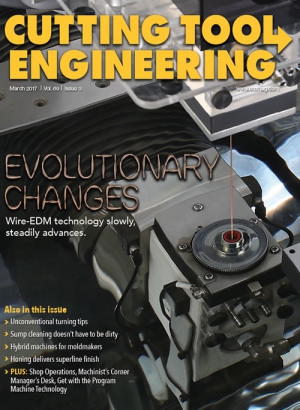 Eighty percent of Americans prefer to buy American-made goods than imported ones. Moreover, 60 percent of Americans are willing to pay 10 percent more for a U.S.-manufactured product than the same type of product made overseas, said Pierre Viaud-Murat, vice president of sales at cutting tool manufacturer Ceratizit USA Inc.
Eighty percent of Americans prefer to buy American-made goods than imported ones. Moreover, 60 percent of Americans are willing to pay 10 percent more for a U.S.-manufactured product than the same type of product made overseas, said Pierre Viaud-Murat, vice president of sales at cutting tool manufacturer Ceratizit USA Inc.
U.S. toolmakers should “claim the origin of [their] products,” he said during a speech at an industry event hosted by the grinding-machine and EDM builder Vollmer. Viaud-Murat pointed out, though, that manufacturers should not claim a product is U.S.-made if it isn’t. Doing so could result in legal action against the offending company, initiated by the Federal Trade Commission.
According to FTC rules, claiming a product is U.S.-made requires that “all or virtually all” of the product be produced in the U.S. The FTC states: “ ‘All or virtually all’ means that all significant parts and processing that go into the product must be of U.S. origin. That is, the product should contain no — or negligible — foreign content.”
Viaud-Murat cited examples of products that did and didn’t meet the commission’s U.S.-origin requirements:
- A gas grill fabricated in America that incorporates knobs, tubes, pipes and assorted fittings manufactured in Mexico met the FTC standard. The Mexican components weren’t considered integral to the grill’s operation.
- A lamp consisting of an imported wood base and a U.S.-made metal stand and glass shade did not meet the standard. The commission deemed the imported base a “significant” component of the lamp.
- A wrench made from a Chinese forging was ruled as not made in the U.S., despite the fact 85 percent of the tool’s value came from grinding processes performed in America.
U.S. companies should use a qualified origination term when foreign content in their products exceeds FTC rules. Examples include:
- “Made in U.S.A. of U.S. and Imported Parts.”
- “Designed in U.S.A., Made in China.”
- “Ground and Coated in U.S.A.”
- “60% U.S. Content.”
Besides cutting tools, Ceratizit USA, Warren, Mich., produces carbide powders and carbide blanks in Pennsylvania. “Using U.S.-made carbide blanks is a marketing opportunity” for American toolmakers, said Viaud-Murat, noting that Ceratizit USA’s powders and blanks cost approximately 3 percent more than those produced at the parent company’s plants in China.
Sales of the company’s American-made blanks and powders are “doing well,” Viaud-Murat said, and output can be increased if demand rises.
[Note: Cutting Tool Engineering magazine is written, edited, produced and printed in the U.S. on U.S.-made paper.—Ed.]
Contact Details
Related Glossary Terms
- electrical-discharge machining ( EDM)
electrical-discharge machining ( EDM)
Process that vaporizes conductive materials by controlled application of pulsed electrical current that flows between a workpiece and electrode (tool) in a dielectric fluid. Permits machining shapes to tight accuracies without the internal stresses conventional machining often generates. Useful in diemaking.
- grinding
grinding
Machining operation in which material is removed from the workpiece by a powered abrasive wheel, stone, belt, paste, sheet, compound, slurry, etc. Takes various forms: surface grinding (creates flat and/or squared surfaces); cylindrical grinding (for external cylindrical and tapered shapes, fillets, undercuts, etc.); centerless grinding; chamfering; thread and form grinding; tool and cutter grinding; offhand grinding; lapping and polishing (grinding with extremely fine grits to create ultrasmooth surfaces); honing; and disc grinding.










